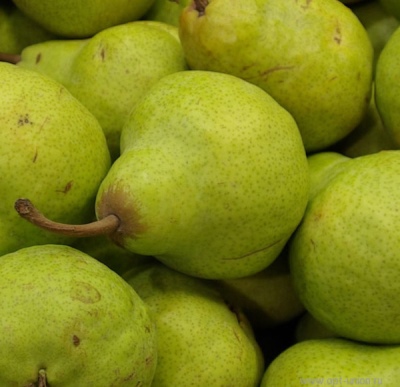
- Name synonyms: Anju
- Ripening terms: late
- Height, m: 3,5-4
- Fruit color: light green and yellow-green
- Skin : very thin
- Pulp : juicy
- Flowers: small, with pale cream colored petals
- Taste: sweet
- Consumer maturity: mid September - late October
- Fruit size: very large
The Anju pear variety is also called Anju. It is very popular among gardeners, since this species will allow you to get a full harvest with good taste.
Description of the variety
The variety is of two distinct types: green and red. In the first case, the peel on the fruit will be pale green in color, it remains unchanged throughout the ripening of the fruit. In the second variety, the skin has a yellow-red color.
A healthy tree will be approximately 3.5-4 meters tall. Often the pear of this variety is also used as an ornamental plant in the garden, because it is distinguished by abundant and beautiful flowering. A large number of small fragrant flowers with cream-colored petals appear on the tree.
Fruit characteristics
The ripe fruits of such a pear are rather large in size. They have a juicy pulp and a very thin skin. Their shape is ovoid.
Taste qualities
This variety has a pleasant sweet taste. Ripe fruits can be eaten fresh. And also they are often added to jam, casseroles.
These pears keep their shape perfectly, but it is worth remembering that during heat treatment their skin can darken and become much tougher, therefore, when preparing various dishes with such fruits, it is better to immediately remove the skin.
Ripening and fruiting
The Anjou variety belongs to the late species. Consumer maturity occurs only in mid-September - late October. In this case, you can send the fruits for storage, but not longer than 3-5 days.

Yield
This variety has an average yield level. It will largely depend on the degree of acidity of the soil, compliance with all the basic rules of planting and care.
Landing
In the process of planting such trees, the distance between individual seedlings should be observed. It should be approximately 3.5-4 meters. The distance between the rows should be about 5 meters.


Growing and care
Before planting plants, special attention should be paid to the selection of seedlings. They should be 1-2 years old. And also they must have a well-developed rhizome, a healthy trunk without damage.
Immediately before planting, the roots of purchased plants are shortened by about 10 centimeters. Then they are placed in a bucket of warm water for 5-6 hours.
When choosing a suitable place for growing, it must be borne in mind that this species is thermophilic. He will need a lot of sunlight.
At the same time, it is permissible to plant trees on almost all types of soil. But drained, fertile land will be best suited. Such vegetation should not be planted in clayey places.
In the selected area, you need to dig planting holes with a depth of about 80-90 centimeters. The bottom of each such hole is filled with a fertile earth mass. It is worth preparing it yourself by mixing peat and compost with each other.
On top of such a mixture, the roots of the seedlings are carefully laid out. They are evenly distributed over the bottom of the planting holes. The root system will need to be sprinkled with earth a little. At the same time, the trunk circle is slightly tamped.
After that, the land is watered abundantly. Remember that pollinating plants should also be planted at a distance of 4-5 meters from the seedlings.
Anjou does not tolerate stagnant water in the ground, so it is too often not worth watering the vegetation. One watering every two weeks will be enough. The number of procedures can be increased only in cases of prolonged droughts.
Excessive moisture can provoke root rot, and then the death of plantings. To get the maximum yield, the pear must be fertilized in a timely manner. In the spring season, the vegetation is fed with compounds that contain nitrogen. They provide an active build-up of green mass.
In the process of fruiting, the best option will be top dressing, which contains phosphorus and potassium. The frequency of fertilization will directly depend on the age of the planting. Older plants will need more nutrients.
Mature trees will need to be pruned periodically. In the process of this procedure, old and diseased branches are removed. They do it all in the spring season. Pruning helps prevent crown thickening. It is better to treat all cut sites at once with disinfectants.
The Anjou pear has good frost resistance, so it is not covered for the winter. In this case, it is recommended to cover young plants with a layer of mulch about 30-35 centimeters high. For these purposes, it is better to use peat. This will protect the root system of vegetation from sudden temperature changes.
Sometimes sawdust is used instead of peat. With the onset of heat, the layer must be removed. Otherwise, the pear may begin to rot.




Like any other fruit trees, the pear needs protection from various diseases and pests. When planting a pear on your site, you need to know in advance what diseases you should beware of. To successfully carry out the struggle, it is necessary first to correctly identify the cause of the problem. It is important to distinguish signs of disease from manifestations of the presence of insects, mites, caterpillars and other types of pests.





































































